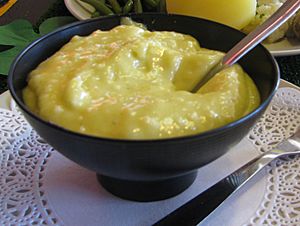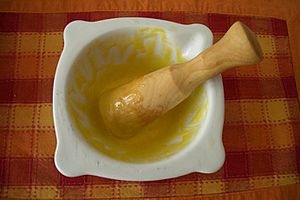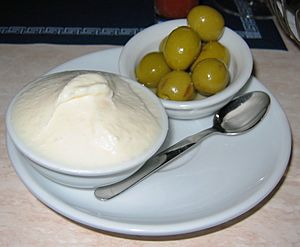Aioli facts for kids

Aïoli
|
|
| Type | Sauce |
|---|---|
| Place of origin | Eastern Spain and Southern France |
| Main ingredients | Olive oil, garlic |
Aioli (pronounced eye-OH-lee) is a yummy cold sauce. It's made by mixing garlic and olive oil until they become a smooth, creamy sauce. This special mix is called an emulsion. You can find aioli in many dishes around the northwest Mediterranean Sea, from parts of Spain to Italy.
The name "aioli" actually means "garlic and oil" in languages like Catalan and Provençal. It's a popular sauce in coastal areas of Spain (like Catalonia), France (Provence), Italy (Sicily and Calabria), and Malta.
Some types of aioli are a bit like mayonnaise. They might have egg yolks and lemon juice added. Other versions are made only with garlic and olive oil. These can be thicker and sometimes harder to make. There are many ways to make aioli, like adding lemon juice or other spices. In France, some people even add mustard!
Just like mayonnaise, aioli is an emulsion. This means tiny drops of oil are spread out evenly in water. In Spain, some people believe real aioli should not have egg. But in France and other places, egg or egg yolk is often used to help make the sauce smooth.
Since the 1990s, in the United States, many flavored mayonnaises are called "aioli." But for people who love traditional aioli, the real sauce should only have garlic and olive oil, plus a little salt.
Contents
What's in a Name?
The word "aioli" is simple! It comes from words that mean "garlic" and "oil."
The English word "aioli" comes from the French word aïoli. This word itself comes from the Occitan language. In Catalan, it's spelled allioli. In Spanish, it's often called alioli, but you might also hear ajoaceite.
How to Make Aioli
Traditional Method
Traditionally, aioli is made by hand using a mortar and pestle. First, you crush garlic with some salt. Then, you slowly add olive oil, drop by drop, while mixing it all together. This careful mixing helps the sauce become thick and creamy.
Modern Ways to Make It
Today, many people use a food processor or blender to make aioli. It's much faster! However, some people who love traditional cooking say that using machines doesn't give the same special texture as making it by hand.
Serving Aioli
With Other Foods
Aioli is a very versatile sauce. In Malta, people often add crushed crackers or tomato to their aioli.
In the Occitan region of France, aioli is usually served with seafood, fish soup, and croutons (small pieces of toasted bread). For example, a dish called merluça amb alhòli is fish served with aioli.
In some parts of Italy, aioli is eaten with boiled potatoes that have salt and bay laurel leaves.
The Grand Aioli Meal
In Provence, France, there's a special meal called le grand aïoli. This is a big dish with lots of different foods served with aioli. It usually includes boiled vegetables like carrots, potatoes, and green beans. It also has poached fish (often salted cod), snails, canned tuna, other seafood, and boiled eggs. Everything is served with a big helping of aioli!
This grand meal is often eaten during celebrations for the patron saints of Provençal towns. It's also traditional to eat it with snails on Christmas Eve and with cod on Ash Wednesday. Aioli is so important in Provence that a famous poet named Frédéric Mistral even named his newspaper L'Aiòli in 1891!
The Provençal fish soup called bourride is also usually served with aioli.
In Spain
In Spain, especially in Catalonia and Valencia, allioli is often served with rice dishes like arròs negre (black rice) and arròs a banda. It also goes well with grilled snails, lamb, rabbit, and vegetables. You might find it with boiled cod or even with boiled quince or pear. Other vegetables commonly eaten with aioli include beets, fennel, celery, and raw tomato.
Images for kids
See also
 In Spanish: Alioli para niños
In Spanish: Alioli para niños






